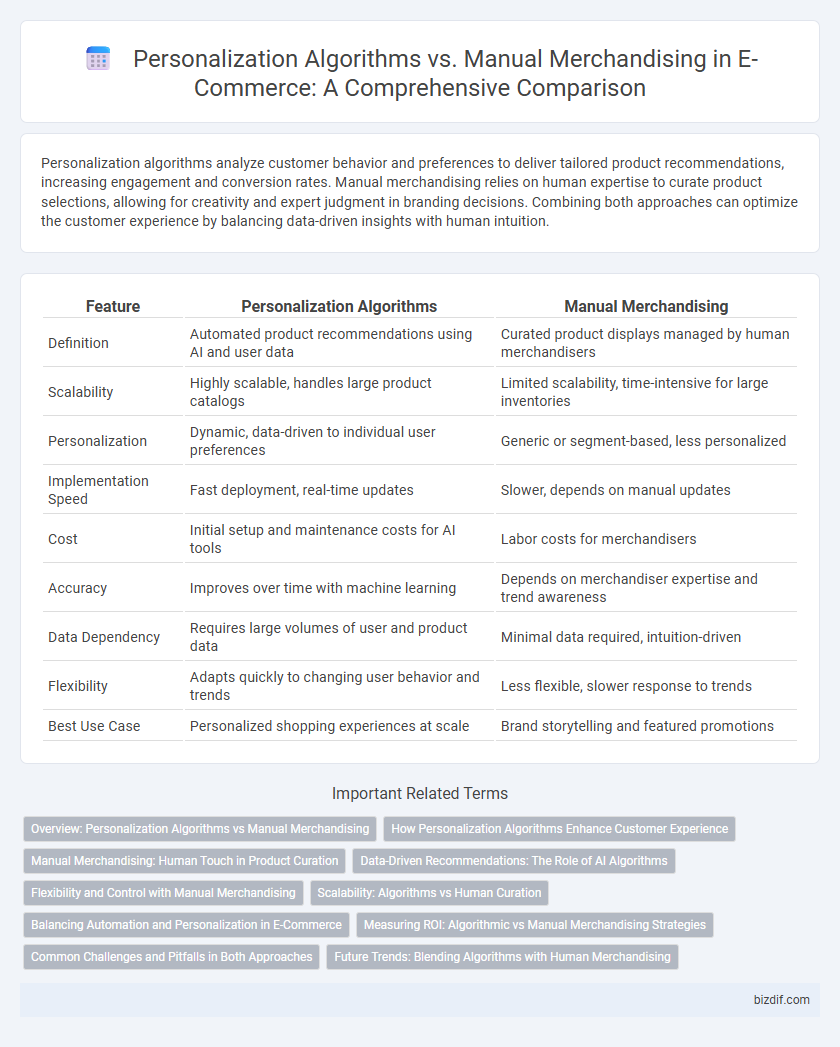Personalization algorithms analyze customer behavior and preferences to deliver tailored product recommendations, increasing engagement and conversion rates. Manual merchandising relies on human expertise to curate product selections, allowing for creativity and expert judgment in branding decisions. Combining both approaches can optimize the customer experience by balancing data-driven insights with human intuition.
Table of Comparison
| Feature | Personalization Algorithms | Manual Merchandising |
|---|---|---|
| Definition | Automated product recommendations using AI and user data | Curated product displays managed by human merchandisers |
| Scalability | Highly scalable, handles large product catalogs | Limited scalability, time-intensive for large inventories |
| Personalization | Dynamic, data-driven to individual user preferences | Generic or segment-based, less personalized |
| Implementation Speed | Fast deployment, real-time updates | Slower, depends on manual updates |
| Cost | Initial setup and maintenance costs for AI tools | Labor costs for merchandisers |
| Accuracy | Improves over time with machine learning | Depends on merchandiser expertise and trend awareness |
| Data Dependency | Requires large volumes of user and product data | Minimal data required, intuition-driven |
| Flexibility | Adapts quickly to changing user behavior and trends | Less flexible, slower response to trends |
| Best Use Case | Personalized shopping experiences at scale | Brand storytelling and featured promotions |
Overview: Personalization Algorithms vs Manual Merchandising
Personalization algorithms leverage machine learning and data analytics to tailor product recommendations based on individual customer behavior, preferences, and browsing history, resulting in dynamic and scalable merchandising. Manual merchandising relies on human expertise to curate product displays and promotions, often based on seasonal trends, inventory considerations, and intuitive market knowledge. While personalization algorithms enable real-time customization and improve conversion rates through predictive modeling, manual merchandising provides nuanced control and brand storytelling that can enhance customer engagement.
How Personalization Algorithms Enhance Customer Experience
Personalization algorithms in e-commerce analyze customer behavior, purchase history, and preferences to deliver tailored product recommendations that increase engagement and conversion rates. These algorithms dynamically adjust the online shopping experience by predicting customer needs, resulting in higher satisfaction and repeat purchases. Manual merchandising lacks this real-time adaptability, making personalization algorithms essential for creating a seamless and relevant customer journey.
Manual Merchandising: Human Touch in Product Curation
Manual merchandising leverages human expertise to craft personalized shopping experiences by selecting and arranging products based on nuanced customer insights and market trends. This human touch allows for adaptive curation that considers emotional appeal, seasonal relevance, and brand storytelling, which algorithms may overlook. Expert merchandisers enhance product discovery and customer engagement by integrating qualitative judgment with quantitative data.
Data-Driven Recommendations: The Role of AI Algorithms
Personalization algorithms leverage AI-driven data analysis to optimize product recommendations, significantly enhancing customer engagement and sales conversion rates. These algorithms process large datasets, including browsing history, purchase patterns, and demographic information, to tailor the shopping experience in real-time. In contrast, manual merchandising relies on human intuition and fixed rules, which often lack the scalability and adaptation speed of AI-powered data-driven recommendations.
Flexibility and Control with Manual Merchandising
Manual merchandising allows retailers greater control over product placements and promotional strategies, enabling tailored experiences that align with brand identity and seasonal trends. Unlike personalization algorithms, manual merchandising offers flexibility to quickly adapt displays based on real-time insights and business objectives. This approach ensures curated product assortments that resonate with target audiences while maintaining strategic oversight.
Scalability: Algorithms vs Human Curation
Personalization algorithms leverage machine learning and big data to analyze customer behavior at scale, enabling real-time product recommendations across millions of SKUs. Manual merchandising relies on human expertise for curated selections but faces limitations in scaling, as human capacity restricts the volume and frequency of updates. Consequently, algorithms provide superior scalability by continuously optimizing and adapting product displays without proportional increases in operational costs.
Balancing Automation and Personalization in E-Commerce
Personalization algorithms leverage machine learning to analyze customer behavior, enabling tailored product recommendations that increase conversion rates and sales. Manual merchandising allows expert curators to apply nuanced insights and brand vision, maintaining a distinctive shopping experience that algorithms alone cannot replicate. Balancing automated personalization with human-driven merchandising ensures e-commerce platforms optimize customer engagement while preserving brand authenticity.
Measuring ROI: Algorithmic vs Manual Merchandising Strategies
Measuring ROI in e-commerce reveals personalization algorithms generate higher conversion rates and average order values compared to manual merchandising by analyzing vast consumer data in real-time for tailored recommendations. Manual merchandising incurs greater labor costs and slower adaptation to market trends, limiting scalability and responsiveness to customer preferences. Investing in algorithmic solutions delivers quantifiable improvements in customer engagement metrics and revenue growth, proving superior efficiency in merchandising strategies.
Common Challenges and Pitfalls in Both Approaches
Personalization algorithms in e-commerce often struggle with data quality issues and cold start problems, limiting their ability to accurately predict customer preferences. Manual merchandising faces challenges such as scalability, consistency, and the subjective biases of merchandisers, leading to inefficiencies and missed optimization opportunities. Both approaches risk overfitting their recommendations to narrow data sets or personal judgments, resulting in decreased customer engagement and revenue potential.
Future Trends: Blending Algorithms with Human Merchandising
Future trends in e-commerce emphasize blending personalization algorithms with manual merchandising to optimize customer experience and boost conversion rates. Machine learning algorithms analyze vast amounts of data for real-time, personalized product recommendations while human merchandisers apply creativity and brand insight to ensure relevance and emotional appeal. This hybrid approach leverages algorithmic precision and human intuition to create dynamic, engaging shopping journeys that adapt to evolving consumer behavior.
Personalization Algorithms vs Manual Merchandising Infographic

 bizdif.com
bizdif.com